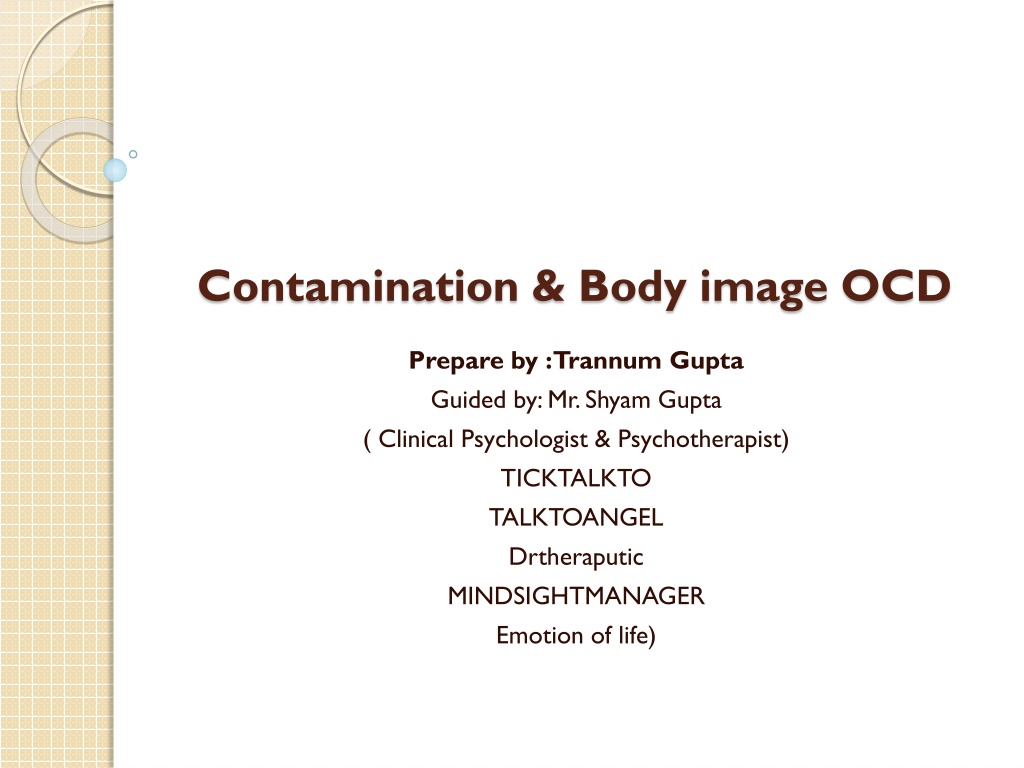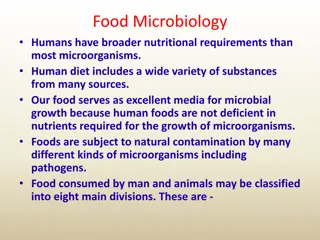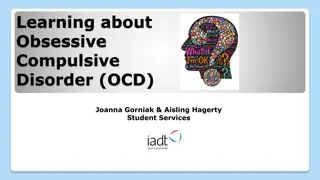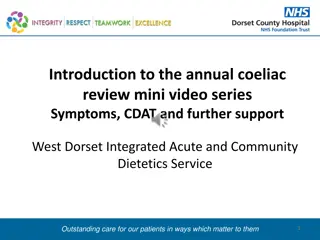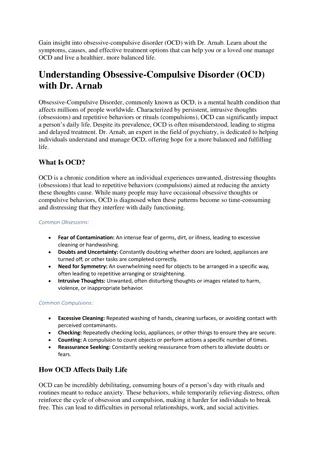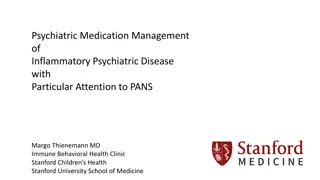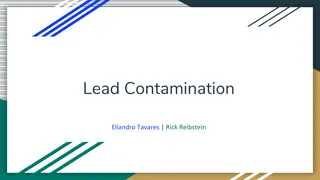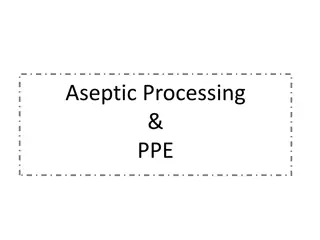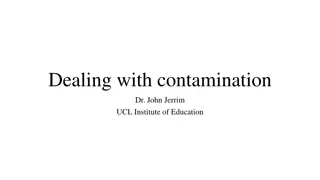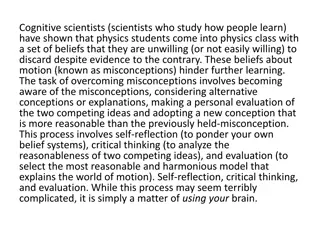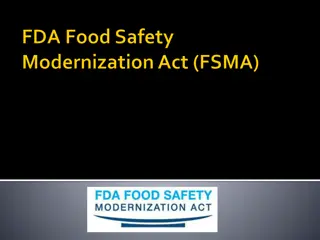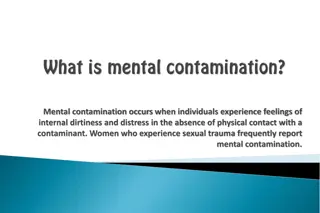Understanding Contamination OCD: Symptoms, Obsessions, and Misconceptions
Contamination OCD is a subset of OCD characterized by severe fears of becoming contaminated by germs or getting sick. Individuals with this condition may exhibit compulsions such as avoidance, excessive washing, and health testing. It's crucial to differentiate between normal intrusive thoughts and OCD-related anxieties to seek appropriate help. Misconceptions about Contamination OCD, like assuming all individuals with OCD have contamination fears or are overly organized, should be addressed to promote better understanding and support.
Download Presentation

Please find below an Image/Link to download the presentation.
The content on the website is provided AS IS for your information and personal use only. It may not be sold, licensed, or shared on other websites without obtaining consent from the author. Download presentation by click this link. If you encounter any issues during the download, it is possible that the publisher has removed the file from their server.
E N D
Presentation Transcript
Contamination & Body image OCD Prepare by : Trannum Gupta Guided by: Mr. Shyam Gupta ( Clinical Psychologist & Psychotherapist) TICKTALKTO TALKTOANGEL Drtheraputic MINDSIGHTMANAGER Emotion of life)
Contamination OCD Contamination OCD is a well-known subset of OCD whereby sufferers are terrified that they might become contaminated by germs or get sick. The most common obsession associated with Contamination OCD is fearing you ll get a terminal illness like AIDS or cancer. Everyday situations like touching door handles and subway poles, or sharing a glass of water, can make you extremely anxious. You re also scared that someone else who s touched these objects could be contaminated.
Common Contamination OCD obsessions Fear of getting AIDs or other serious diseases. Fear that someone you love will die from germs. Fear of coming into contact with potentially harmful things like viruses, bacteria and bodily fluids.
Common Contamination OCD compulsions Avoidance:Avoiding objects, places and people that you fear could threaten your health. Protection:Wearing gloves or using paper towels to try and stop germs from touching your skin. Excessive Washing:Repeated or overlong showering, hand-washing, using antibacterial soap or heavy-duty cleaning products on your skin. Excessive health testing:Repeatedly getting tested for diseases like AIDS or STDs to be absolutely certain that you re healthy.
Common misconceptions about Contamination OCD That everyone with OCD has Contamination OCD. In fact, many people with OCD have no contamination fears whatsoever. That people with Contamination OCD are very fussy, uptight or super-organized. That people might start to believe in their illogical concerns.
How to Know if its OCD? Everyone gets intrusive thoughts,but having them doesn t mean you have OCD. For people who do have OCD,these thoughts can be debilitating,causing extreme anxiety and discomfort. People with Contamination OCD experience anxieties that go far beyond what is considered normal. Their fears are much more severe than the usual I don t want to get sick or That surface is really dirty concerns.
Having intrusive thoughts does not make you a bad person. They are a misfiring in the brain, not a reflection of your character.
Everyday Examples Your roommates are always touching everything: the refrigerator handle, the faucet, the bathroom light switch. You can t touch any of those things without putting your sleeve over your hand. You take the bus to work. Most of the time, you never get a seat, so you re forced to hold on to the pole. You use a tissue so your hand doesn t directly touch it. At work, you disinfect your entire desk every morning, just in case a cleaner has touched your things overnight.
Is Recovery Possible ? Yes! People with Contamination OCD can get much better through Exposure Response Prevention Therapy (ERP). ERP is when the patient voluntarily expose themselves to the source of their fear over and over again, without acting out any compulsion to neutralize or stop the fear. By repeatedly facing something they re afraid of, they force their brain to recognize how irrational it is.
Examples of ERP treatment Therapist may ask to make a list of things the patient is afraid of like touching door handles or not washing hands. Therapist may then ask to rank the things on the list by how anxious they make them feel. Therapist then starts the exposure exercises starting with the relatively low-level anxiety tasks. Soon ,the tasks will become more challenging as one move down the list and patient might have to do things like handing a homeless person a quarter or touching the faucet in a public bathroom.
Other Treatment Options Mindfulness -based Cognitive Behavioral Therapy, also known as CBT, teaches people to identify, understand and change negative thinking patterns and behaviors. Patients are taught problem-solving skills during therapy lessons and then instructed to practice them on their own time in order to build positive habits.
Can medication help? Medication can help alongside ERP, but it shouldn t replace it. Doctors should always be consulted before considering medicinal options. The main family of medicines used to treat OCD are known as Selective Serotonin Reuptake Inhibitors, or SSRIs. SSRIs enhance the natural serotonin activity and are used to treat major depressive disorders and anxiety conditions. Examples : Lexapro, Prozac, Paxil and Zoloft.
What is the goal of therapy? Some people with Contamination OCD recover completely through ERP. But for many, their obsessions never fully go away. OCD recovery has more to do with managing the condition, than it does with eliminating it. However, that doesn t mean one cannot lead a healthy, happy life. By prioritizing treatment and positive lifestyle habits, sufferers often gain confidence and freedom. Even if some anxiety is still present by the end of therapy, they ll no longer feel debilitated by the condition.
OCD with Body image disorders Although all health workers are aware of the persistent and constant concern and preoccupation with food in such body image disorders rejection or constant evacuation of food few have focused on the intrinsically obsession-compulsive nature of this concern. Unlike the true reduction of appetite in depressive disorders, here there is a conscious and deliberate refusal of food. The lack of correct perception of bodily cues related to hunger is a late development in the course of the illness, but a striking early pre- starvation factor is the constant awareness of mild to strong feelings of hunger. In addition to this awareness of hunger, there is a persistent preoccupation with food in a concrete way in the form of ruminative calorie counting and mental imaging of food.
Obsessions , Compulsions and Intrusive thoughts in Body Image Disorders Preoccupation by incessant thoughts revolving around body image, weight gain, and food intake, leading to ritualistic methods of eating dieting and exercising. Feelings of being fat despite the reality the mirror portrays, and is thus forever checking stomach to make sure that one has not gained weight, but is never satisfied and therefore is compelled to lose weight by any means necessary. Concerns of physical appearance, and consequently alter their eating patterns in order to lose weight accordingly.
Continued. Obsessive-compulsive rituals of cutting or weighing food, in the hopes of restricting food intake and losing weight in the process. Counting the number of mouthfuls chewed or pieces of food in a meal according to some fixed or magical number that is correct or just right. Washing hands to remove trace amounts of oil that might cause weight gain if ingested. Throwing out food in a can because it was discovered to contain too many calories after reading the label. Constantly asking the waiter about contents of dishes so as to stay away from having any butter oil or fat. Refusing to enter the kitchen for it will only lead to the temptation to eat and thus get fat.
Other Symptoms Constant exercise Loss of hair on head Fatigue and muscle tiredness, headaches Obsession with food and calories Amenorrhea (loss of menstruation) Unusual eating habits (i.e. cutting food into tiny pieces, picking at food) Mood swings Anaemia Loss of hair on head Fine downy hairs on face, neck, back
Continued Dizziness Pale complexion, dehydration Severe food restriction Extremely low body weight Intense fear of gaining weight Lack of menstruation among girls and women. Relentless pursuit of thinness and unwillingness to maintain a normal or healthy weight. Distorted body image and self-esteem that is heavily influenced by perceptions of body weight and shape, or a denial of the seriousness of low body weight.
Treatment Treatment of such OCD subtype varies depending on the individual circumstances. There is no one single line of treatment. The initial treatment is usually focused on immediate weight gain, especially with those who have particularly serious conditions that requires hospitalization. Psycho-therapy is also an effective form of treatment and can lead to restoration of weight, return of menstrual periods in female patients, improved psychological self-image and normal social functioning. In some cases, medication such as anti-depressants may be necessary, especially people with severe depression or serious obsessive-compulsive disorder symptoms.
Treatment which includes drugs and psychological support, aims to: Bring back the person to a healthy, normal weight. Re-instate normal food habits. Treat any physical complication or associated mental, psychological problems. Bring in family support to treat the condition.
THANK YOU Get in touch for any query and concern Visit us : www.emotionoflife.in Write to us : info@emotionoflife.in Call us: 7678694626
